What is the future for alternative power?
04 July 2023
Mike Hayes looks at the power technology for construction equipment that may – or may not – be replacing diesel in the coming years.
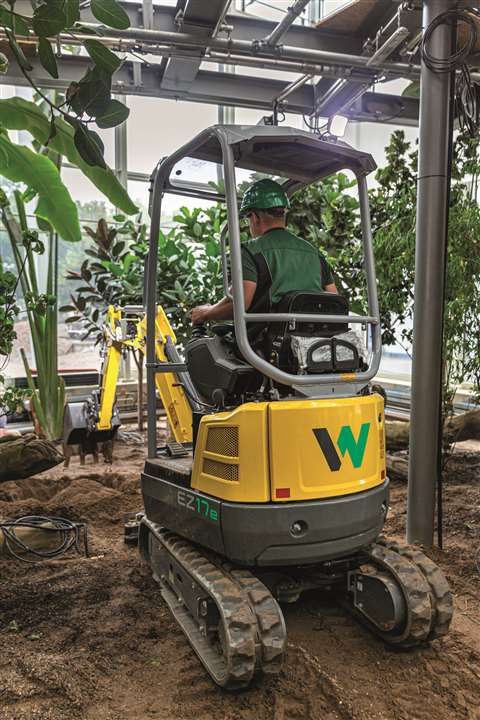 Wacker Neuson’s 1.7 tonne EZ17e fully electric compact excavator (Photo: Wacker Neuson)
Wacker Neuson’s 1.7 tonne EZ17e fully electric compact excavator (Photo: Wacker Neuson)
If, in the past, the thought of renewing your fleet of construction machines has caused you anxiety, look away now; things are about to get a lot more complicated.
Furthermore, if you thought this was simply a question of making the switch from diesel to electric, well, even there it’s not so simple. To start with, let’s look at battery technology…
One of the major drawbacks of the lithium-ion batteries that are beginning to make in-roads into construction is their modest power density, which currently holds back their ability to power heavy equipment for a full working day.
Another drawback – perhaps even more significant – is the cost. Whereas it was anticipated that the cost of batteries – and therefore the cost of battery-powered construction equipment – would fall as the technology became more widespread, in fact the cost of lithium has skyrocketed, which is one reason for the purchase price of a battery-electric machine currently standing at between two and three times that of its diesel equivalent.
Even allowing for potential reductions in fuel costs and maintenance over the lifespan of the machine, many contractors will be hesitant to take the plunge, especially given the current power density challenges.
Powering up alternative power options
A 20-tonne excavator, for example, will be hard-pressed to give a full day’s unbroken service on lithium-ion batteries, although Volvo’s recently-unveiled and fully-electric 22 tonne machine, the EC230, does promise an 8-hour shift, with a high-powered charge “during a lunch break”. This machine is currently being piloted with customers, but will constitute a major breakthrough for machines in this size class if it does come to market.
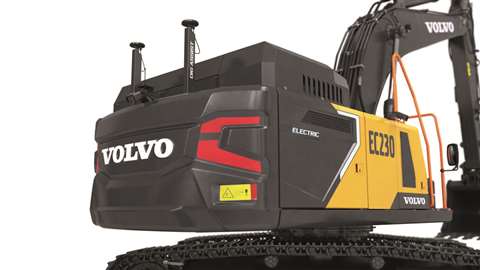 Volvo’s electric EC230 excavator promises up to a 70% reduction on running costs v diesel (Photo: Volvo CE)
Volvo’s electric EC230 excavator promises up to a 70% reduction on running costs v diesel (Photo: Volvo CE)
Notwithstanding a number of larger battery-electric machines making waves in construction, the fact remains that, without significant developments, in both power storage capacity and cost, electricity is likely to remain the ‘fuel’ of choice for compact mobile machines only.
In compact equipment, the technology does present some clear advantages – especially for projects taking place in urban or other sensitive or enclosed areas; these include zero local emissions and significant noise reduction, as well as simplified maintenance and servicing.
As an example, Wacker Neuson – a specialist in urban construction equipment – recently launched its 1.7 tonne EZ17e electric mini-excavator; the first of its kind with zero tail swing.
The company says the machine can run for a typical workday, as well as operate continuously in a stationary position, with a power source connection.
Furthermore, says Wacker Neuson, the excavator can be recharged in five to six hours using a common 240-volt, single-phase outlet.
While still in its infancy in construction, battery-electric machines such as this are increasingly being seen as must-have technology for contractors tendering for inner-city projects.
Other power technologies, however, are available and all are nibbling away at the pie that was once the sole preserve of diesel.
What are the benefits of HVO?
HVO (Hydrotreated Vegetable Oil) is of particular interest to equipment manufacturer Liebherr.
HVO is obtained from, for example, cooking oil waste, grease and fat residues, waste fats and vegetable oil. The manufacture and use of HVO is nearly climate-neutral when only renewable energy sources are used in the production process.
In its pure form, or as an additive to conventional diesel, many machines can already operate in an almost climate-neutral manner, as HVO can be directly used in conjunction with conventional combustion engines without having to convert the machine. CO2 emissions can then be significantly reduced – up to 90% in fact, compared with conventional diesel.
Liebherr says all of its engines are approved for HVO, without having to be retrofitted. The company says it ensures that the HVO it uses is mainly from vegetable waste and completely free from palm oil.
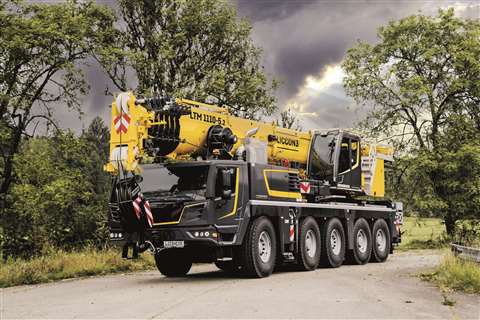 Liebherr says all of its engines are ready to accept HVO, without the need for conversion (Photo: Liebherr)
Liebherr says all of its engines are ready to accept HVO, without the need for conversion (Photo: Liebherr)
The problem with this fuel is its availability; the amount of suitable wastes required for HVO production are unlikely to be available in sufficient quantities on a permanent basis.
Nevertheless, Liebherr believes HVO currently represents a fuel option that can make an important contribution to defossilising the industry.
Another major manufacturer, Komatsu, is also making a strong commitment to vegetable oil, having recently announced a switch to HVO as factory-fill fuel for equipment produced in Europe.
The move started last month at plants in Hannover, Germany, and Birtley in the UK.
Much like Liebherr, Komatsu says the combustion engines in its machines – including those produced for the construction and demolition industries – can be operated with HVO with no modifications required and describes the switch as a major step towards reducing its environmental impact.
This shift to HVO runs alongside Komatsu’s continuing research into and development of a range of alternative power technologies and solutions, such as electric and hydrogen-powered machines.
Hydrogen as a fuel for construction equipment
Speaking of hydrogen, the jury still appears to be out on whether hydrogen fuel cell technology or hydrogen as a fuel within an internal combustion engine will prevail.
However, following extensive research in both technologies, JCB has been extolling the virtues of hydrogen as a fuel.
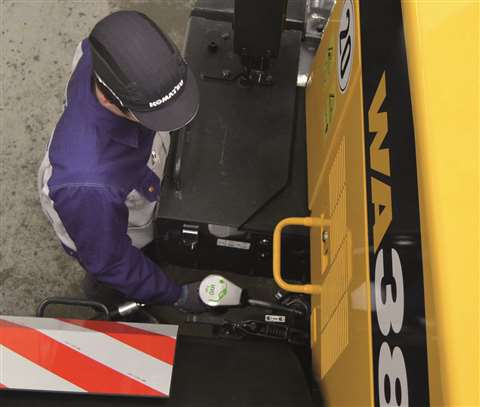 Filling a Komatsu machine with HVO at the company’s Hannover plant in Germany (Photo: Komatsu)
Filling a Komatsu machine with HVO at the company’s Hannover plant in Germany (Photo: Komatsu)
Talking to KHL’s Becky Schultz about the time and effort JCB has put into developing this technology, Tim Burnhope, the company’s chief innovation and growth officer, said, “We studied the 76 papers – experiments by universities, top companies – and what we realised when we got to the end of it was that the majority of those engines were conversions.”
The researchers realised that most academic attempts involved trying to put hydrogen into an existing spark ignition engine.
Burnhope said, “You wouldn’t put petrol in a diesel engine and expect it to work. And that’s really what people have been doing with hydrogen.
“The problem was the combustion was probably high pressure, high temperature. The fuels were probably too rich. So, the outcomes were fairly poor.”
After dissecting the studies, JCB engineers identified 11 key technical challenges that needed to be addressed. Of these, the majority, said Burnhope, came back to how you combust hydrogen in the first place, including the need to combust at much lower temperature and pressure and at a very lean mix of hydrogen to air.
JCB now has its hydrogen combustion engine fitted and working in multiple pieces of equipment, and pre-production engines are rolling off a dedicated production line in the UK.
Paul McCarthy, JCB’s chief engineer for hydrogen engines performance, controls & integration, said of the developments, “We’ve actually built our 50th hydrogen engine, so this isn’t a science experiment. This is real. This is happening. We’re already proving out our production techniques [so that it] will be ready to build.”
Stacks of fuel cells
At the recent Hannover Messe event in Germany, Accelera, a division of engine maker Cummins, exhibited a range of hydrogen solutions, including the latest in fuel cell technology.
The company says its proton exchange membrane (PEM) fuel cell technology uses pure hydrogen to generate zero-emissions electricity, which can be used in heavy construction equipment.
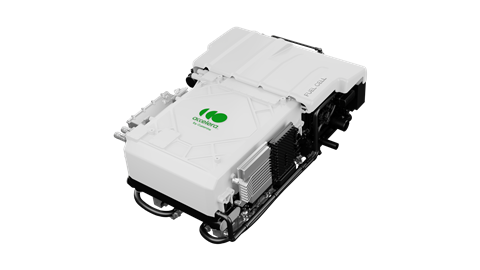 Accelera’s fourth generation fuel cell engine – the FCE150 (Photo: Accelera)
Accelera’s fourth generation fuel cell engine – the FCE150 (Photo: Accelera)
In fact, Accelera claims the technology is scalable and lightweight and can be customised to meet the demands of applications of all sizes.
At its booth in Germany, the company displayed its fourth-generation fuel cell engine, the FCE150. The modular engine operates with zero greenhouse gas or common emissions, and it can be stacked to generate a 300kW solution, making it suitable for heavy duty off-road machines.
One might say engine makers and equipment manufacturers are sitting on the fence about the future of power technology. They themselves would say no single power source that will replace diesel in the construction industry.
Contractors may have anxiety about their equipment purchases for some time to come.
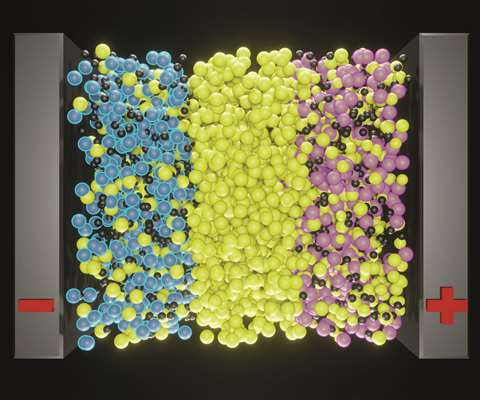
MAN Energy Solutions recently supplied a methanol reactor to a pilot project in Chile that is creating synthetic, climate-neutral fuel.
The Haru Oni project takes advantage of excellent wind conditions near the city of Punta Arenas in southern Chile to generate the so-called eFuels with the help of renewable power.
Uwe Lauber, CEO at MAN Energy Solutions, said, “Synthetic fuels are an important component on the road to a climate-neutral future. They have the potential to decarbonise all those sectors and processes where direct electrification is not possible or practical.”
In the first process step, electrolysers use the wind power to split water molecules into their basic components, oxygen and hydrogen.
The green hydrogen is then combined with CO2 filtered from the air in MAN Energy Solutions’ methanol reactor. The result is green methanol, which is then converted into climate-neutral gasoline in a further step.
In the pilot phase, the large-scale plant is producing around 130,000 litres of eFuels.
By next year, capacity is expected to be increased to around 55 million litres of eFuels per year. By 2026, it is hoped production will have increased to around 550 million litres per year.
New battery-electric machines are entering the market at a significant rate, but significant barriers remain to greater adoption of the technology.
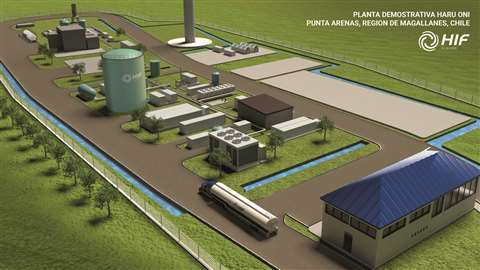
Among new battery developments currently being investigated, two in particular are showing potential, in terms of improving power density and safety and reducing cost.
The first is solid-state battery tech, which uses ceramics or other solid materials in place of liquid electrolyte. These liquids have always been something of an issue in batteries, as they are highly flammable.
Solid-state batteries are also proving able to move charge around more rapidly.
On the downside, there have been issues with battery degradation and it is unlikely we will see them powering construction machines until that issue has been overcome.
The second technology involves exchanging lithium with sodium – a mineral that is found in far greater abundance than the metal currently being mined at increasing cost.
Furthermore, a sodium-ion battery is likely to improve safety, being less flammable than its lithium-ion counterpart.
So far, however, sodium has not proven itself in terms of improving on or even matching lithium’s power density, but tests are ongoing.
One change we will almost certainly see in future batteries is an improvement in the cathode material, which currently tends to be graphite. Alternatives such as silicon, which are now being tested, could improve energy density and speed up charging.
STAY CONNECTED




Receive the information you need when you need it through our world-leading magazines, newsletters and daily briefings.
POWER SOURCING GUIDE
The trusted reference and buyer’s guide for 83 years
The original “desktop search engine,” guiding nearly 10,000 users in more than 90 countries it is the primary reference for specifications and details on all the components that go into engine systems.
Visit Now
CONNECT WITH THE TEAM










